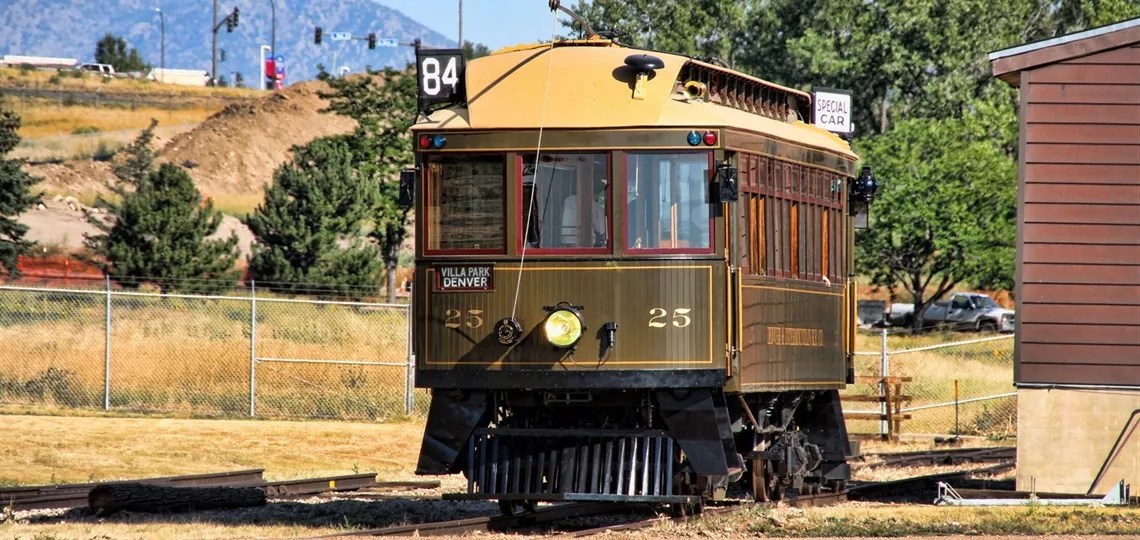
Flickr/Jeffrey Beall

Audio By Carbonatix
RTD’s W Line connects Union Station with the Jefferson County government center, serving western metro commuters each day as it runs through the prominent Denver suburb of Lakewood.
But there’s more to the W Line than getting from place to place: From century-old trolley routes to brutalist architecture, the light rail route can also serve as a sightseeing tour for those interested in Lakewood history.
May is Archaeology & Historic Preservation Month, and Lakewood’s Historic Preservation Commission has been activating people around city history for the last few weeks. This year, the commission’s preservation month committee created a self-guided tour of Lakewood architecture and history along the W Line.
“They collected available archival information about the different locations from a variety of sources, including Heritage Lakewood Belmar Park and RTD archives, and took additional photos, as well,” explains Matthew Seubert, a principal planner with the city who serves as the staff liaison for the Historic Preservation Commission.
This year, make your gift count –
Invest in local news that matters.
Our work is funded by readers like you who make voluntary gifts because they value our work and want to see it continue. Make a contribution today to help us reach our $50,000 goal!
One of those sources was put together in 2009 by current Denver City Councilman Kevin Flynn, who was a journalist before he moved to the communications department at RTD after the Rocky Mountain News closed, and is now in his third term as an elected official. His History of the West Corridor discusses how Lakewood grew from an agriculture-based area into the city it is now.
The seven-member committee is made up of volunteers appointed by Lakewood City Council. In the past, the commission has sponsored architectural scavenger hunts and presentations to community groups, Seubert notes, but committee members wanted to do something different this year.
“The idea for the event and all of the content was the creation of the commission,” Seubert says.
Historical Stops on Lakewood’s W Line
The W Line stops in Lakewood at the Federal Center, Oak, Garrison, Lakewood Wadsworth and Lamar stations. Each station has unique architecture and pieces of Lakewood history, according to the new guide.
As documented in the tour materials created by the Historic Preservation Commission, a breeze brick facade can be seen west of the Wadsworth station on Carr Street. That area was once home to the West Colfax Fuel & Feed Co. The building that housed the business was demolished in 1996, but the feed company played a key role in early Lakewood history as a place where the orchards, farms and dairies could get supplies.

An old trolley car at Lakewood’s Federal Center station is a small slice of the city’s new historical guide for RTD riders on the W Line.
City of Lakewood
Parts of the W Line follow an old trolley route used in Lakewood in the early 1900s; the Wadsworth station was on that trolley route.
“During the trolley years, this station was known as the Devinney Station,” the guide explains. “The station was named after Valentine Devinney, who had a large orchard to the south.”
Architectural styles like brutalism, modern mirrored office towers, clipped gable roofs and barrel roofs are all visible from the W Line, according to the self-guided tour. Fun facts about the different styles are also part of the experience.
“Notice the clipped gable roof on this 1927 English Norman-style home,” the tour directs. “Clipped gable roofs reduce wind force where it is at its greatest on a gable design, which is at the peak.”
In addition to what’s visible, the tour provides brief snapshots of historical activity along the W Line. The Denver Ordinance Plant was built in 1941 by the U.S. military, close to where the Federal Center station is now, according to the guide. “Production peaked in the summer of 1943 with an output of 6.2 million 30-caliber cartridges per day for guns, tanks and aircraft,” it says. “Twenty thousand people, half of them women, worked three shifts.”
According to the guide, that plant was partially responsible for Lakewood’s shift from an agricultural area to a suburb, because workers settled there permanently after World War II ended. The City of Lakewood was officially incorporated in 1969.
The tour suggests riding the train both ways to get the full experience, which costs just $2.75 after RTD lowered its fares at the beginning of the year. Plus, the W Line is one of Denver’s only rail lines not impacted by RTD’s major rail reconstruction project that will start May 26 and last the entire summer.